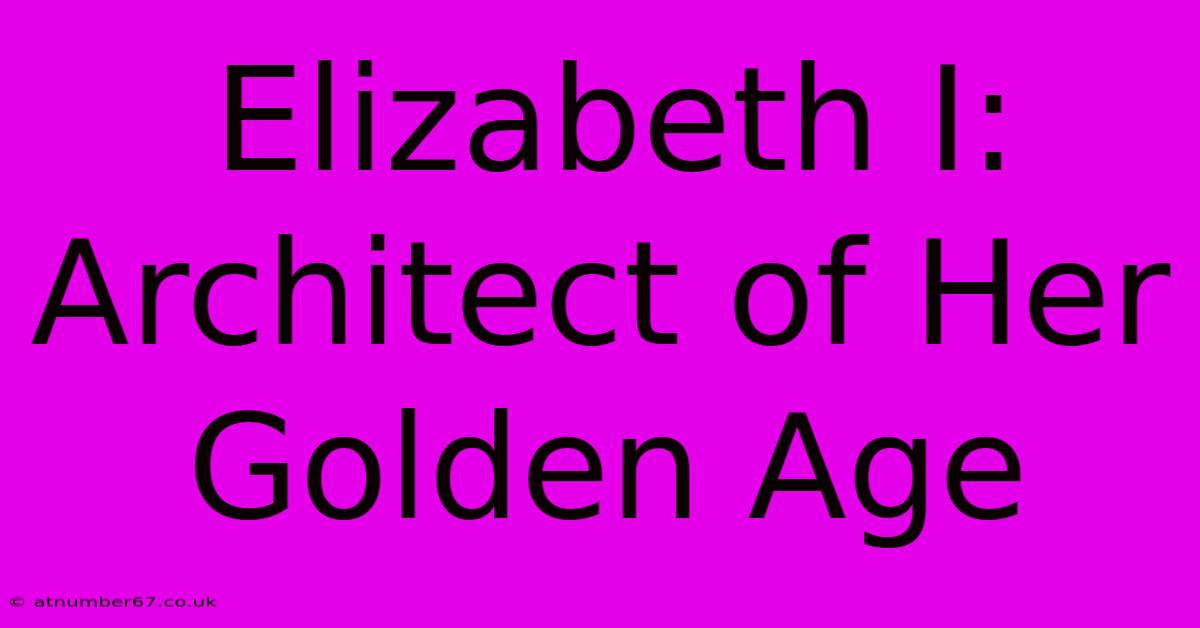Elizabeth I: Architect Of Her Golden Age

Table of Contents
Elizabeth I: Architect of Her Golden Age
England's reign under Elizabeth I (1533-1603), often dubbed the "Golden Age," was a period of unprecedented cultural flourishing, political stability, and burgeoning exploration. But this wasn't mere luck; it was the product of a shrewd, strategic, and often ruthless queen who skillfully navigated treacherous political waters and shaped her kingdom's destiny. This article explores how Elizabeth I, through her actions and policies, became the architect of this remarkable era.
A Legacy Forged in Fire: Early Life and Political Landscape
Elizabeth's early life was fraught with peril. The daughter of Henry VIII and Anne Boleyn, she was declared illegitimate after her mother's execution, a fact that cast a long shadow over her claim to the throne. This precarious start instilled in her a deep understanding of power dynamics and the necessity of political maneuvering. Navigating the turbulent reigns of her half-siblings, Mary I and Edward VI, she learned to cultivate allies and remain cautiously neutral while maintaining her ambition. Her survival became a testament to her political acumen and resilience.
Mastering the Art of Political Pragmatism
Elizabeth's reign was characterized by a masterful balancing act. She skillfully played the religious factions against each other, adopting a policy of religious moderation known as the Elizabethan Religious Settlement. This pragmatic approach, while not satisfying everyone, avoided the religious conflicts that had ravaged England under her predecessors. By avoiding outright persecution of Catholics, while maintaining Protestantism as the state religion, she secured a fragile peace. This political dexterity was crucial in establishing a stable foundation for her Golden Age.
Flourishing Arts and Culture: A Golden Age Blossoms
The relative peace and prosperity of Elizabeth's reign fostered a remarkable flowering of arts and culture. This period witnessed the emergence of some of England's most celebrated literary figures, including William Shakespeare, Edmund Spenser, and Christopher Marlowe. The burgeoning theater scene saw the construction of the Globe Theatre, and plays became a powerful form of entertainment and social commentary, reflecting the spirit of the times.
Patronage and Prosperity: Fueling Artistic Creativity
Elizabeth actively cultivated this artistic renaissance through her patronage of artists and writers. She recognized the power of art to shape national identity and project England's burgeoning strength on the world stage. Her support of artistic endeavors wasn't simply a display of wealth; it was a deliberate strategy to create a national narrative that celebrated England's greatness, and the era saw an explosion of artistic talent.
Exploration and Expansion: Reaching for New Horizons
Elizabeth's reign also marked a pivotal moment in England's exploration of the wider world. Sir Francis Drake's circumnavigation of the globe and the establishment of the East India Company symbolized England's growing global ambitions. This expansion wasn't merely driven by a thirst for adventure but also a strategic move to secure trade routes and challenge the dominance of Spain. This outward expansion helped further solidify England’s position as a major European power.
Naval Strength and Global Influence: A New Era of Power
The strengthening of the Royal Navy under Elizabeth's rule was paramount to her success. It allowed for the protection of England's growing trade interests and enabled her to challenge Spain's naval supremacy. The defeat of the Spanish Armada in 1588 stands as a powerful symbol of England’s growing power and cemented Elizabeth’s place as a strong, decisive ruler. This event helped to secure England’s future as a dominant global player.
The Virgin Queen: A Calculated Image
Elizabeth’s deliberate choice to remain unmarried, famously declaring herself the “Virgin Queen,” was not simply a personal decision; it was a shrewd political strategy. It allowed her to avoid the potential pitfalls of dynastic alliances and maintain her absolute control over the kingdom. This carefully cultivated image also contributed to her powerful, almost mythical status, which helped solidify her rule and the nation’s sense of unity.
Legacy and Conclusion
Elizabeth I’s reign stands as a testament to her political acumen and strategic vision. Through careful negotiation, skillful diplomacy, and a keen understanding of the importance of culture and power, she transformed England into a dominant European force and ushered in a period of remarkable cultural and artistic flourishing. The legacy of Elizabeth I continues to resonate today, making her not just a queen, but a powerful symbol of an era defined by its ambition, resilience, and glory.

Thank you for visiting our website wich cover about Elizabeth I: Architect Of Her Golden Age. We hope the information provided has been useful to you. Feel free to contact us if you have any questions or need further assistance. See you next time and dont miss to bookmark.
Featured Posts
-
Zahide Age Practicing Mindfulness
Apr 04, 2025
-
How Rich Is Jack Vettriano Really
Apr 04, 2025
-
Lana Del Reys Net Worth The Numbers Dont Lie
Apr 04, 2025
-
The Duterte Paradox Power And Popularity
Apr 04, 2025
-
Sackler Family From Riches To Ruin
Apr 04, 2025
